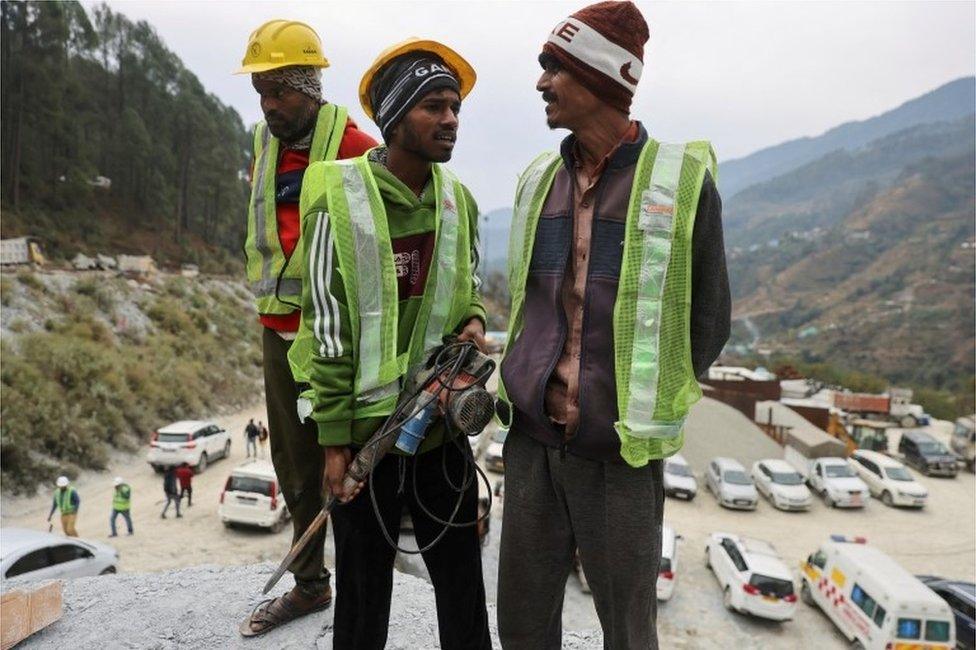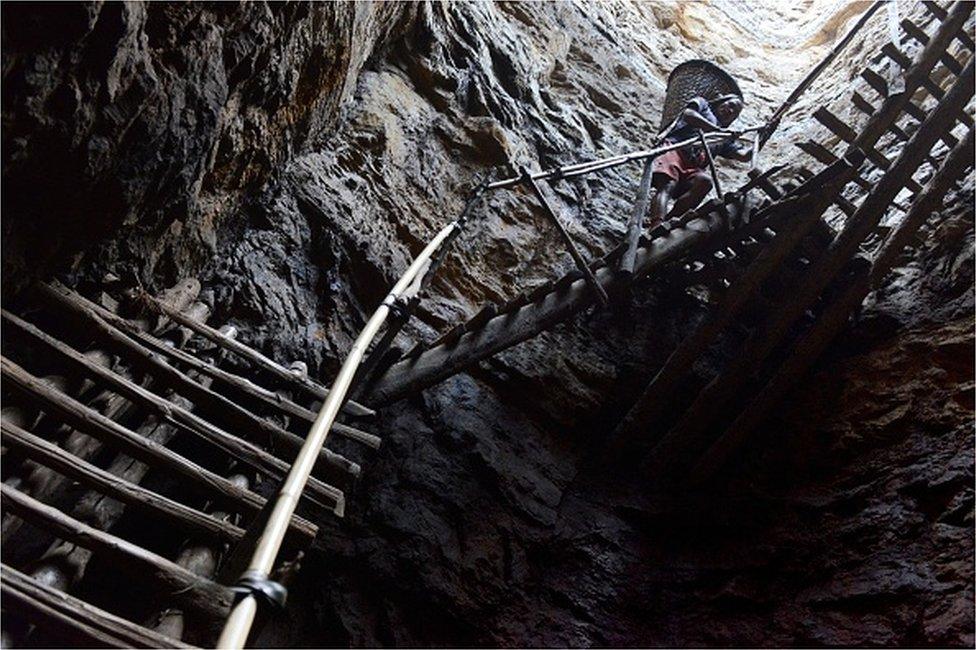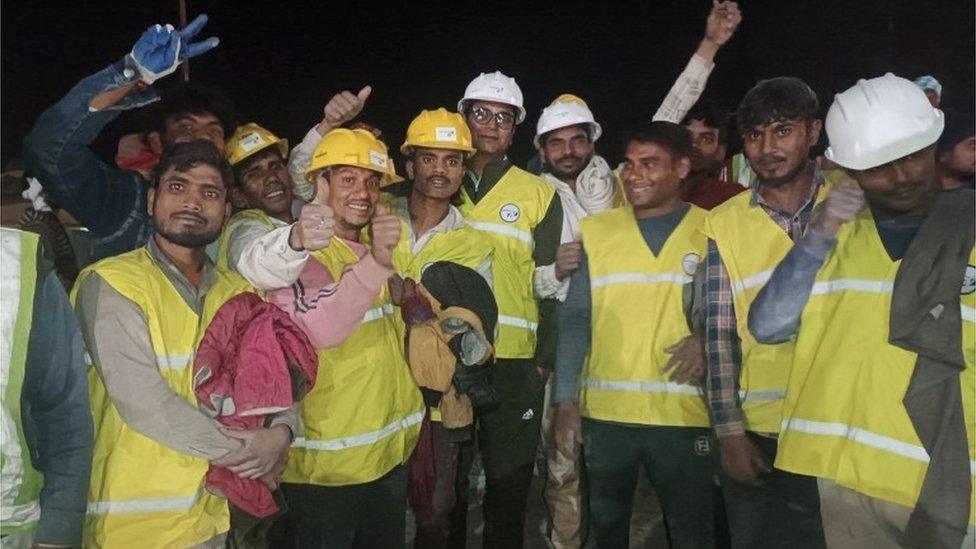How India's 'rat-hole' miners freed 41 tunnel workers
- Published

A dozen so-called 'rat-hole' miners cleared the last stretch of debris to reach the trapped workers
"I removed the last rock and saw them. Then I went to the other side. They hugged us, lifted us. And thanked us for taking them out," Munna Qureshi told reporters on Tuesday evening after coming out of a Himalayan tunnel in the northern Indian state of Uttarakhand.
He was among a dozen or so workers who cleared the last stretch of debris by hand to help free 41 workers who had been trapped in the under-construction 4.5km (3-mile) Silkyara tunnel for more than 16 days. A landslide had caused a portion of the tunnel - part of the $1.5bn (£1.19bn), 890km-long flagship Char Dham project to connect key Hindu pilgrim sites - to cave in on 12 November.
Mr Qureshi, 29, has been described by officials and media alike as a "rat-hole" miner and hailed as "the hero of the rescue operation". He and his mates crawled into the 800m pipe and cleared the 12m debris of the last stretch in under 18 hours, according to Lt-Gen Syed Ata Hasnain, a senior official overseeing the operation. They were "confident and nonchalant" about the work they were doing, willing to "go in with anything... no special tools as such", he told NDTV., external
Miners employing the hazardous "rat hole" technique engage in the excavation of narrow, purpose-built pits in the ground, large enough for one person to go down and extract coal. The nimble miners - usually slim boys and men - carry loads of wet coal in baskets up on wooden slats flanking the walls of these mines, mostly found in the north-eastern state of Meghalaya. The Supreme Court banned it in 2014, but it continues illegally.

'Rat-hole' mining was used to extract coal from narrow and deep mines in Meghalaya
In January 2019, some 15 miners lost their lives when they were trapped for more than a month in one such mine.
"Once we went down, there was hardly any light streaming in from above," a man who left his job at a 'rat-hole' mine in Meghalaya told the BBC in 2019. "The mines I had worked in earlier were only about 30ft (9m) deep. But this was far more dangerous. It was nearly 400ft deep."
In Uttarakhand, engineers believe, labelling the rescue workers who entered the pipe as "rat-hole miners" may not be entirely accurate. They call them manual excavators, who go into tight spaces to clean and carry out repairs - most of the so-called 'rat-hole" miners at the tunnel worked in cities fixing water and sewer pipes.
Skilled tunnelling mechanics and manual excavators had to be deployed at least thrice during the operation to clear blockages in the tunnel.
The first time it happened was last week when the main auger drilling machine broke down inside the tunnel, engineers said.
There are two essential parts of the machine: the auger or rotating spiral blades that do the actual drilling and the machine itself, powered by an internal combustion engine, an electric motor or hydraulic power.

A total of 41 workers were rescued from the Silkyara tunnel on Tuesday
In the Uttarakhand tunnel, the auger machine was cutting through the earth and pushing in pipes of 900mm (3ft) diameter through a 60m wall of debris to create an escape passage for the trapped workers.
Last week, the auger's drilling blades came to an abrupt halt at 39m when they hit a rebar. "We withdrew the machine because the auger blades cannot cut through steel," explains Vipin Gupta, managing director of Trenchless Engineering Services, one of the firms engaged in the operation.
It was then that a team of mechanics and manual excavators, armed with gas torches, entered the pipe and skilfully cut through the impediment of steel rebars.
The machine resumed operations only to find itself ensnared days later in a chaotic assembly of steel debris at around 48m. Engineers say the auger blades got entangled in the debris last week and could neither push, pull or rotate.
The men re-entered the pipe, severing the entangled auger blades with gas torches. Over the course of three days, they cleared both the blades and other debris, say engineers.

An auger machine did most of the drilling work to create an escape passage
"All of this created a lot of heat, and we were under continuous threat of getting burn injuries. Going inside that cramped space is hard in itself, but using gas cutters for hours inside is on a whole different level. It's a game of stamina and experience," Praveen Yadav, a tunnelling mechanic, told The Indian Express., external
At this point it was decided to manually excavate the last stretch of 12m because of the possibility of the blades getting stuck in the debris again. "Who knows we could have encountered more steel debris ahead and the operation would have slowed down," says Mr Gupta.
The final breakthrough possibly was the most challenging manual operation.
This time the helmeted men, carrying spades and pulling wheeled trolleys, crawled into the rather constricted and sweltering pipe. The auger machine pushed the rescue pipe, drawing in the debris- it's like pushing a cup into the sand at the beach which collects the sand itself.
The men, working in teams, loaded the debris into the the trolleys that were subsequently hauled out. The entire operation was completed in under 24 hours. Social media exploded with paeans to 'jugaad' or a low-cost inventive Indian hack to fix things.
None of the manual excavators are trained, and many are among the poorest Indians. They are also among the bravest Indians to eke out what is a potentially dangerous living.
"It was a difficult task, but for us nothing is difficult," Firoz Qureshi, one of the miners, told Reuters , externalafter the operation ended.
BBC News India is now on YouTube. Click here, external to subscribe and watch our documentaries, explainers and features.

Read more India stories from the BBC:

